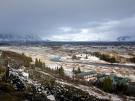|
|
 |
Iceland is part of the Mid-Atlantic Ridge that owes its very
existence to the molten rock, or magma, that wells up through the rifts along the ridge. Scientists believe Iceland rose from
the sea floor about 20 million years ago. Continuous spreading, accompanied by eruptions along Iceland's section of the ridge,
widens the country by about one inch per year.
Over one third of Iceland's 40,000 square miles is volcanically
active and covered with lava fields. Elsewhere, magma too far below the surface to create volcanoes heats the rock above,
sending the heated groundwater percolating to the surface in the form of "hot springs." Iceland is far enough north so that
it should be entirely covered by ice and snow, like Greenland to the west. The heat generated by the ridge, however, keeps
the country in a constant state of thaw, distinguishing it as the Land of Fire and Ice.
|
 |
HEKLA Iceland's most famous and historically most active
volcano can best be described as an intermediate volcanic form between a crater row and a stratovolcano. It is located west
of Iceland's SE volcanic rift-zone. Hekla erupts a magma type that is unique for Iceland, intermediate between highly silicic
and andesitic composition. From surface deformation studies after the 1980 eruption, it has been concluded that its magma
chamber is located around 8 km below the summit. Since the Middle Ages, Hekla's has been one of the most active volcanoes
of the world, with recorded major eruptions in 1104, 1158, 1206, 1222, 1300, 1341, 1389, 1510, 1597, 1636, 1693, 1766, 1845,
1947, 1970, 1980, 1991 and 2000. Typically, at least the beginning parts of Hekla's eruptions are largely explosive. Some of these eruptions caused
great damage, especially the eruptions in 1510, 1693 and 1766. Note that since 1970 the repose interval appears to have changed,
becoming much shorter and quite regular, around 10 years, with respect to an approximately 50 years rhythm during the preceding
centuries. Hekla has also had a number of large prehistoric but postglacial eruptions, producing vast amounts of tephra which
repeatedly covered up to two thirds of the country with light-coloured tephra (i.e. 7000 B.P., 4500 B.P., 2900 B.P., A.D.
1104 and A.D. 1158). The total volume of lava produced by Hekla in historical times is about 8 km3, and the total volume
of tephra about 7 km3.
934 Eldgjß eruption of the Laki volcano system on Iceland
released 19.6 km│ (4.7 mi│) of flood basalt, one of the larger volcanic eruptions on earth in historical times.
Laki in Iceland in 1783 caused the death
of all the animals and 5% of the population on the island, and may have caused the crop failures in Europe that provoked the
French Revolution. Dust clouds from volcanoes cause cold weather which shows up as frost damage in tree rings. More information
from the ice cores covering the Holocene is desperately needed by archaeologists.
1783-1784 Laki eruption (Icelandic volcano) - Several years of
extreme weather throughout Europe. The famine that ensued is one of the main causes of the French revolution.
Mˇuharindin 1783 - 1785. Literally The Mist
Hardships. 10,000 dead from Volcanic
eruption in Iceland and subsequent famine.
If someone other than me has written an article, I'll be sure to include a byline at the bottom.
This article contributed by Jane Turner.
|
 |
|
|
 |
|
|
 |
|
|
|
|
Feedback, submissions, ideas? Email svanurg@gmail.com
|
|
|
 |

